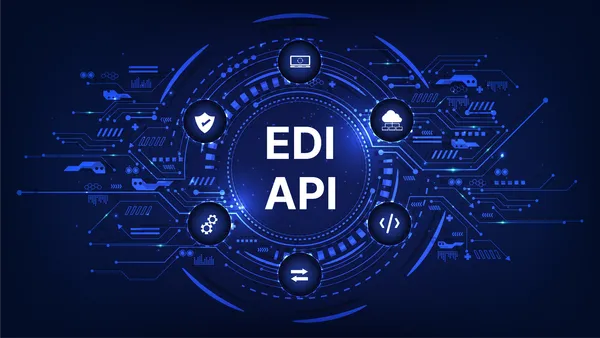If it seemed blockchain was an inescapable buzzword in 2017, consider the evidence. Google searches for "blockchain" rose steadily, picking up significantly toward the end of 2017.
For many, "blockchain" may have been a successive query following the furrowed brows and glassy eyes elicited by "Bitcoin" and "How to buy bitcoin," two of the most popular global Google searches in 2017.
Buying into the hype, companies have added blockchain to corporate names and portfolios for stock benefits. But a host of organizations entered the race for the long run well before it became so popular.
Blockchain made a debut into the Thanksgiving market with turkey tracking this November and also made headlines in a marijuana market regulation proposal. But the winning blockchain application has yet to hit the market.
Now that blockchain is on everyone's radar, what does it mean for the big players?
CIO Dive had the chance to discuss the technology and what's in store for 2018 with Brian Behlendorf, executive director of Hyperledger, the Linux Foundation blockchain project that counts Cisco, Intel, IBM, JPMorgan Chase, R3 and SAP among its premier members.
With blockchain capturing more of the industry's attention than ever, Hyperledger has a lot of work ahead to bring more companies and developers together and sustain momentum and hype. As some begin to question the technology's viability, proving that applications such as multi-ledger systems and identity networks are the future despite time to market constraints will be no easy feat.
It's a team effort
While Hyperledger serves as the platform for various projects and launches training materials and conferences to promote blockchain, it is not necessarily a team of blockchain coders.
"At the end of the day, we're still focused on creating code and acting as, if you will, the air traffic controllers or the referees on the football field," said Behlendorf. "But the actual hard work of writing that code is still up to the individual developers and the companies who put those developers forward."
Consortia and open-source platforms like this have often played key roles in the development of new technologies. For example, Tim Berners-Lee founded the World Wide Web Consortium to develop open internet standards in the mid 1990s, and it's all history from there.
Instead of companies feeling like they are contributing to the progress of a competitor, an organization like Hyperledger offers a "neutral home" for incubating technology. This lets organizations feel as if they are "contributing to a common technology," said Behlendorf.
"There should be PoCs that fail, there should be envelopes that get pushed."

Brian Behlendorf
Executive director of Hyperledger
For example, the interledger protocol seen in Hyperledger Quilt, an interledger protocol tool to help move assets and coordinate transactions across multiple ledgers, has been around for many years. But when Hyperledger brought the technology to its platform, it became more of a community project.
Hyperledger "[took] it from a kind of GitHub repository, sitting off on its own with unclear governance, with an unclear future, and move[d] it to a space where it was going to get more looked at, scrutinized and be swept up with the same flow of visitors and traffic," said Behlendorf.
And Hyperledger is not looking to converge all blockchain users on a single ledger.
"This really realistic notion that the world was not going to converge on one gigantic ledger for all of its public and private transactions" but instead play out across "a universe of different ledgers" was evident to Behlendorf from the beginning.
The enterprise has databases for different use cases, bound together by common software and idioms as well as easy ways to switch between platforms. A similar system will allow companies to work across different ledgers.
"It was important to us to be able to plant a flag in a terrain that said interoperability isn't something you have to solve at the DLT layer, just as we don't all have to use MySql in order to have our databases talk to each other," said Behlendorf. "Instead we should be talking about interledger protocols and specifications."
Looking to the horizon
The industry has seen an increase in blockchain PoCs, pilots and experiments, though around two-thirds do not hold development potential, according to Forrester. Yet the rise in PoCs is coinciding with a growth in PoCs that make it to the pilot or production phase, said Behlendorf. Like any hyped technology, some companies pursue it without understanding what it means for their business or if they need it at all.
"There should be PoCs that fail, there should be envelopes that get pushed," said Behlendorf. "There are plenty of people who want to apply this for use cases where there just might not be the value of doing it."
The more rolls of the dice, the better for the technology, and if all PoCs turned into pilots it would mean that actors aren't being experimental enough, according to Behlendorf. After all, failure can often teach the greatest lessons.
"[I had] this really realistic notion that the world was not going to converge on one gigantic ledger for all of its public and private transactions."

Brian Behlendorf
Executive director of Hyperledger
Hyperledger operates under an "umbrella" strategy that encompasses nine blockchain projects in various stages of development that cover unique blockchain applications. Though they can have competing functions, the projects are unified under the Apache software license, Apache, said Behlendorf.
In addition to Quilt, the consortium is working on Indy, a "self-sovereign identity tool" for large-scale identity networks; and Burrow, an implementation of the Ethereum Virtual Machine. The "cute" names were created to avoid conflict with corporate brands, said Behlendorf.
But what do all of these projects mean for blockchain and companies looking to invest in blockchain in the long run?
A multi-ledger system may still be years or decades away for some organizations, but right now is not too early for companies to start thinking about what such a system would mean for them down the line. After all, companies that get in on the early investment may have more influence on the direction of blockchain development.
Hyperledger is not the only blockchain consortium or developer. The blockchain ecosystem will be one of many ledgers with development priorities that are oftentimes decentralized, and this will create the need for adaptors between ledgers, according to Behlendorf.
"At the end of the day, we're still focused on creating code and acting as, if you will, the air traffic controllers or the referees on the football field."

Brian Behlendorf
Executive director of Hyperledger
The more adaptors that are built between ledgers, the better, but this will require investment and participation by more companies.
Hyperledger and R3 made headlines in December as membership shifted around. For some, these moves indicated weakening support for the technology and consortium, perhaps the result of a dearth of large-scale enterprise implementations in 2017.
But a few players downgrading from Premier membership or leaving consortia is not indicative of a struggling organization, said Behlendorf, who touted Hyperledger's growth in membership.
The consortium nearly doubled in size last year, and in December announced that it had 197 supporting organizations and sold out Premier memberships. Companies choosing to forgo membership could still be contributing in technical ways, such as contributing code, said Behlendorf.












